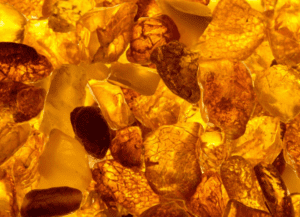AMBER
Amber is considered a gem because it glows and glistens when polished, but it is not actually a gemstone. It is the hardened resin of certain types of ancient trees that have been fossilized over millennia. Because of its unique properties, it has been adorned and studied relentlessly for centuries.
Amber is formed from resin exuded from tree bark, although it is also produced in the heartwood. Resin protects trees by blocking gaps in the bark. Once resin covers a gash or break caused by chewing insects, it hardens and forms a seal.
There are five classes of amber, defined on the basis of their chemical constituents. Because it originates as a soft, sticky tree resin, it sometimes contains animal and plant material as inclusions. Amber occurring in coal seams is also called resinite, and the term ambrite is applied to that found specifically within the New Zealand coal seams.
It is noted for its inclusions, such as insects, pollen, leaves, and other organic debris. Millions of years ago, still-living pine trees trapped these bits in their oozing, sticky fluids. Some of the finer specimens contain whole, trapped termite colonies. The chambers of these structures, created with webbing, are still visible. Nursery chambers still contain egg sacks.
Besides termites and mosquitos, it may contain different varieties of beetles, spiders, mites, and other arthropods. Sometimes, a single piece can even contain many different kinds of organic inclusions.
Gemologists classify amber into various types. The sea type is found undersea. The pit variety is dug up from the ground, especially from the Baltic region. Other types are clear, massive, fancy, cloudy, frothy, fatty, and bone, in reference to their appearance.

USES
Amber has been a popular jewelry stone for thousands of years. However, with a hardness of only 2 to 2.5, it’s very susceptible to damage from accidental scratches. As ring stones, ambers would benefit from protective settings. Necklaces, pendants, or earrings are better options. It often tumble polished and used as beads or cabochons. Faceted pieces are rare.
MOHS HARDNESS
2 – 2.5
LUSTER
Ambers clarity ranges from transparent to opaque and it has a resinous luster. Most specimens have pockets of air bubbles and various other inclusions. Pyrite impurities can sometimes give amber a bluish color. Many varieties have a very cloudy clarity caused by many tiny bubbles; these stones are known as bone amber. The most valuable amber stones are those that contain insects, plants, or pyrite inclusions.
CHEMICAL COMPOUND
Amber is a compound of organic acids. It’s chemical formula is C10H16O. Amber is composed out of several chemical elements. It contains 78% of carbon, around 11% of oxygen and around 10% of hydrogen.
WHERE TO FIND
The main source can be found just west of Kaliningrad, Russia. Amber from this region is found in clay about 100 feet below the surface. The second-largest source of amber is in the Baltic region. Baltic amber comes from the seabed and is often found washed up onshore. It is known for its beautiful golden colors. The Dominican Republic is known for having rare blue-colored amber. Dominican Republic amber is considerably younger than other varieties. Italy, Romania, China, Japan, Burma (Myanmar), Mexico, Canada, and the United States are also known to have deposits.
Arkansas is known as the largest deposit.
New Jersey Amber, sometimes called Raritan amber, is amber found in the Raritan and Magothy Formations of the Central Atlantic (Eastern) coast of the United States. It is dated to the Late Cretaceous, Turonian age, based on pollen analysis of the host formations.
DIAGNOSTIC PROPERTIES
Amber has a melting-point range of 200 to 380°C, but it tends to burn rather than melt. It is amorphous in structure and, if broken, can produce a conchoidal, or shell-like, fracture. It is a poor conductor and thus feels warm to the touch in the cold, and cool in the heat.